Disclosure: This post may contain affiliate links. I earn a small commission of product sales to keep this website going.
Do you ever notice that sometimes, when you capture a series of photos, they all appear to have different exposures? One might be darker than the previous, and the next is brighter?
But they were all captured in the same light, so why would they be different? Don’t you want them to have the same exposure so they have a consistent look?
This is why cameras have an Auto Exposure Lock.
Refresher on exposure modes
It’s important to have a solid understanding of your camera’s exposure modes before knowing how to use Auto Exposure Lock.
Nearly all cameras have four basic exposure modes – Program Auto (P), Aperture Priority (A/Av), Shutter Priority (S/Tv), and Manual (M). Even though only one of those has “Auto” in the name, all but one have an automatic element chosen by the camera.
This means that the camera is choosing your exposure – how bright or dark the final picture will be. You can have a say in this using the Exposure Compensation dial, but that’s still just a reference based on what the camera is seeing through the lens and how the camera is metering.
If you need a refresher on exposure and how these exposure modes work, you can go through my free Exposure Triangle for Beginners course.
What is Auto Exposure Lock?
Auto Exposure Lock lets you use these auto exposure modes as a pseudo-manual mode.
One of the biggest benefits of this is consistency from photo to photo.
Without Auto Exposure Lock (AEL), your exposure may be slightly different in each photo of a series depending on the composition. The camera calculates a new exposure each time you move the camera or zoom your lens. If most of your frame consists of something dark in the first photo, then the next photo a second later mostly consists of something bright, those two photos will be exposed differently.

Why would you want the exposure to change each time you press the shutter button if your lighting and subject aren’t changing?
Auto Exposure Lock will lock in that exposure so that it’s consistent as you recompose your photos. No matter how you change your composition, you’ll have the same exposure from one photo to the next while it’s locked.

Before mirrorless cameras, AEL was also important for metering. Photographers would meter off of a known reflective surface, lock the exposure, and then recompose the photo. This is a bit of a lost art form in today’s digital cameras, but AEL still has value for getting those consistent exposures.
How to use AE Lock
Each camera manufacturer has different user-interface designs for AE Lock. I’d recommend going to your camera manual’s index and reading about Auto Exposure Lock.
The shutter button
Many cameras will lock the exposure when you press the shutter halfway.
Fujifilm cameras, as a default, have this enabled. You’ll compose your photo, press the shutter halfway, and see “EL” in the lower left. Your exposure is locked until you release the shutter button completely.
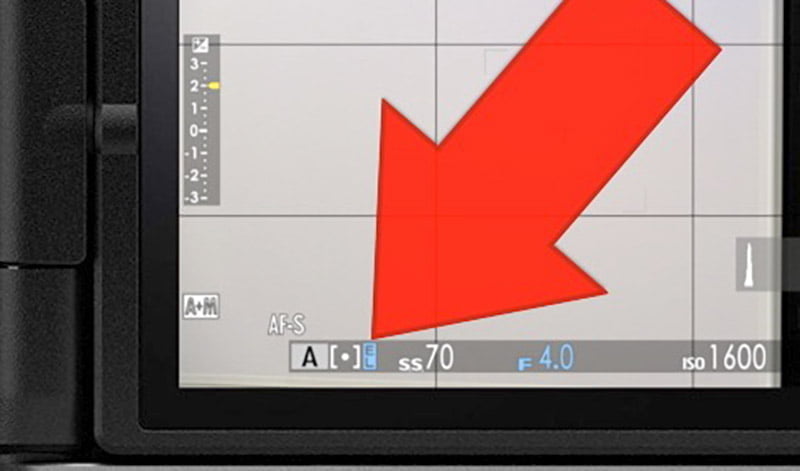
Nikon cameras, on the other hand, do not lock the exposure with the shutter button with the default setup. You’ll have to use an AE-L button instead (covered next).
What does your camera do right now? Just push the shutter halfway and look for the symbology in the screen – either EL, AE-L, or in Canon and Sony cameras it’s an asterisk.
Cameras are customizable, and you can change this behavior.
In Fujifilm cameras, look for Shutter AE in the Button/Dial Setting menu. You can have different behavior depending on your focus mode. For example, you can lock the exposure in AF-S but let the exposure change in AF-C, when you might be tracking something moving across different lighting.
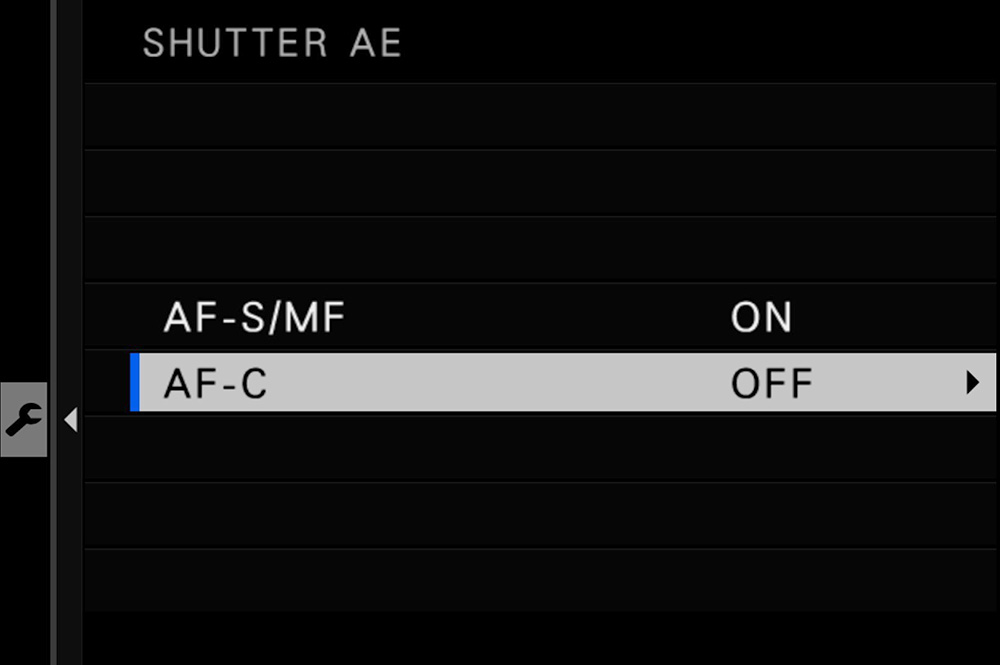
In Nikon cameras, this is Custom Settings c1, Shutter release button AE-L. Options are On (half press), On (burst mode), and Off. The “burst mode” option will only lock the exposure when you press the shutter all the way down, not halfway.
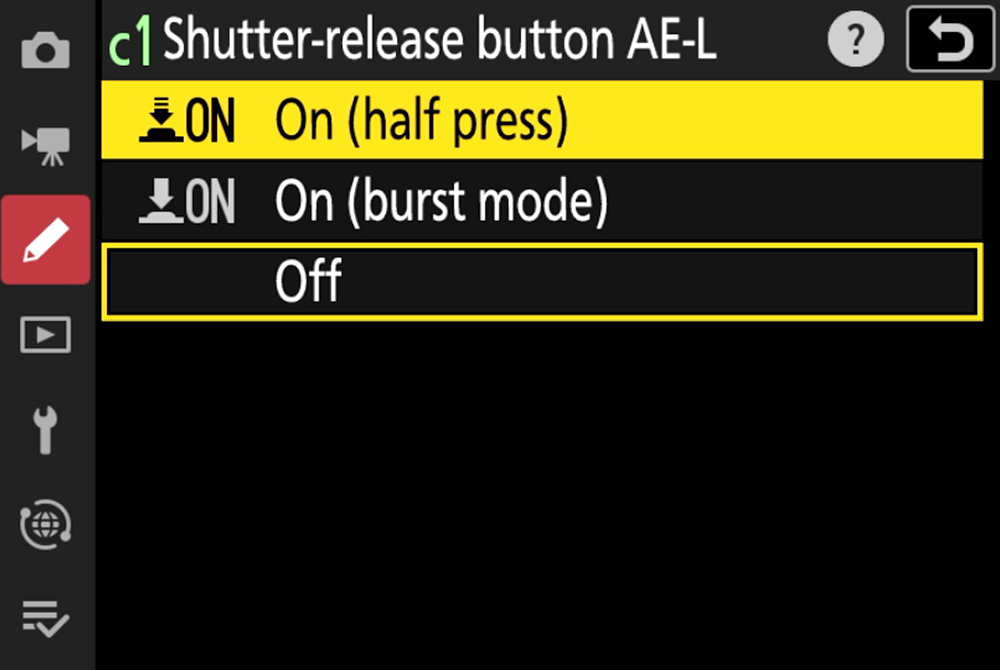
The AE Lock button
In addition to the shutter button, all cameras can also have a separate button to lock the exposure. This button is labeled something like AEL, an asterisk, or, in the case of many Nikon cameras, it’s pushing the sub selector joystick in.
Aside from knowing where your AE Lock button is, it’s also important to understand how the button behaves.
Do you need to keep smashing it down with your thumb to keep the exposure locked? Or does the button behave more like a switch, where you push and release it to lock the exposure, then push and release it again to unlock it?
Push that button, release it, and see what happens with the symbol in the screen.
Again, this is something that your camera manual will be able to answer better than I can cover countless different cameras here.
But let’s again look at Fujifilm and Nikon cameras.
To program AE Lock in Fujifilm:
- Press and hold the DISP button to pull up the Fn Setting screen. Look for/program AE LOCK.
- Go to your Button/Dial Setting menu and look for AE/AF-LOCK MODE. Set this button to only lock the exposure when pushing the button (when pressing) or as an On/Off switch.
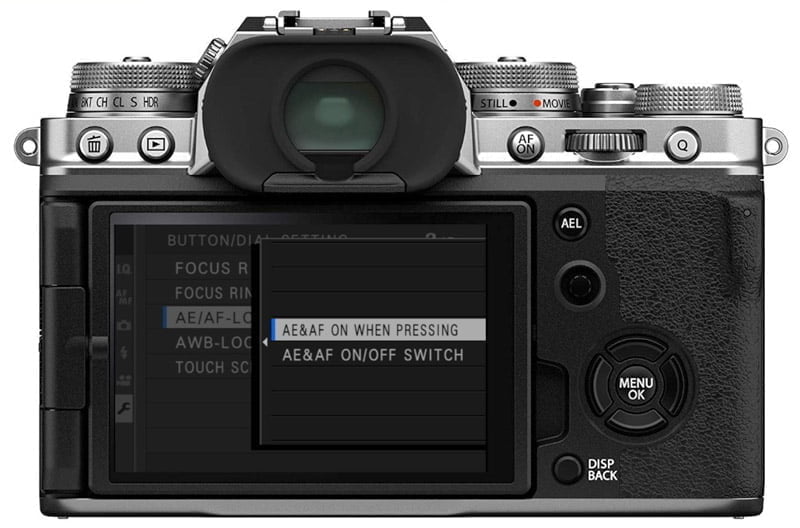
To program AE Lock in Nikon:
- Go to Custom Settings f2, Custom controls. Look for/program AE Lock and set the behavior.
There are a few different behavior options here:
- AE Lock (Hold): The exposure will lock when you press and release the button. The exposure will remain locked until you push the button again or cycle the camera power. This is like On/Off switch behavior.
- AE Lock (Reset on release): The exposure will lock when you press and release the button. It will unlock when you push the button again, cycle the camera power, or take a picture.
- AE Lock Only: The exposure will lock while you hold the button. It will unlock when you release the button.
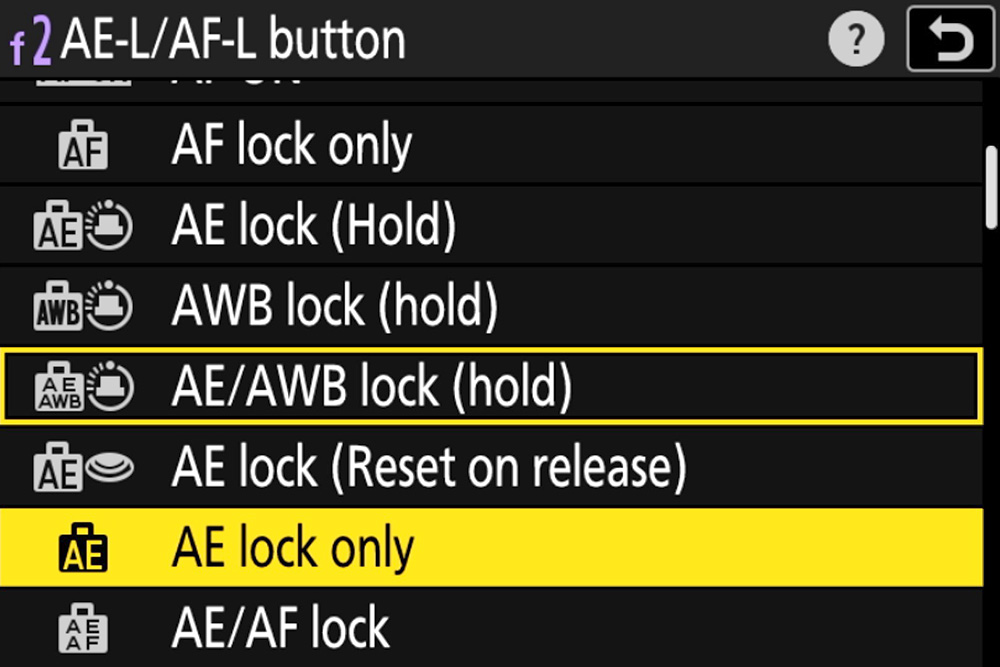
When to push the AE Lock button
You’ll push the AE Lock button when your frame is exposed as you want it.
How do you know when that is? Well, that’s an entirely different and broad topic! You’ll use your Exposure Compensation dial to make the photo brighter or darker. You can use your histogram to determine the proper Exposure Compensation value if you know how to use the histogram.
You can lock the exposure with the shutter, but be aware that may prohibit you from re-focusing as you recompose, depending on how your shutter focus is set. That’s the advantage of the AE Lock button, you can use the shutter half-press to focus as you recompose without worrying about exposure changes.
Look for that display symbology that we discussed earlier, to indicate the exposure is locked. You can recompose all you want now, and the exposure variables won’t change!
Then you just release the button or unlock it when you’re done with that sequence or if the lighting changes.

Final thoughts
Auto Exposure Lock is one of the oldest exposure tools found in digital cameras. A tool to help you get consistent exposures from one photo to the next.
However, with all of the new tools in more modern cameras, many photographers don’t even know this feature exists. Or what it does.
The key, like everything else, is knowing what it does and when to use it.
You don’t need to use it all the time, but you should know the situations in which it will help your photography, and how to use it.
It just might save your bacon one day!

Mark Fernandes
Friday 4th of August 2023
Great article! Very clearly written. Thanks so much.